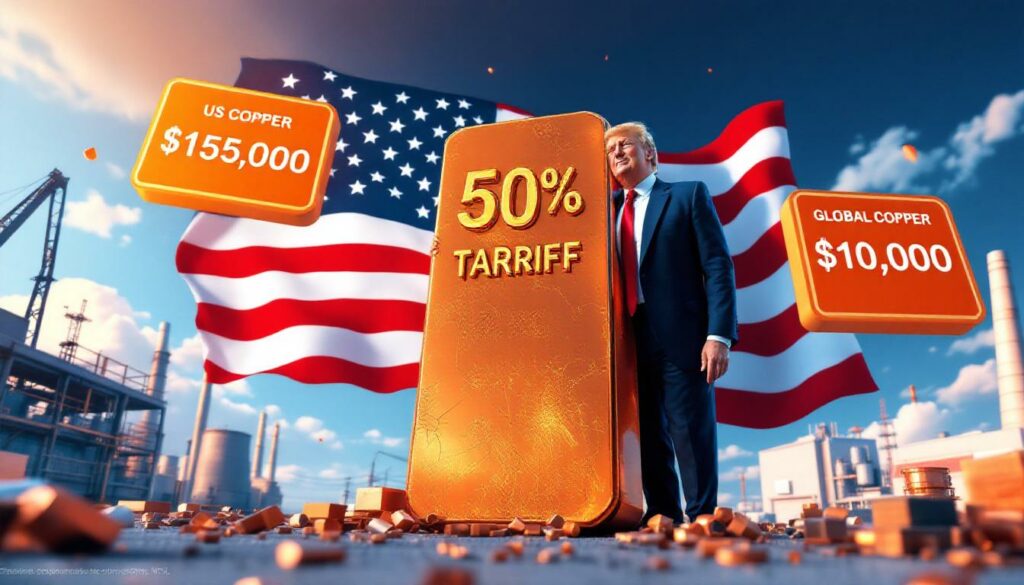Trump's 50% Copper Tariff: Market Impact and Economic Consequences
The announcement of President Trump's 50% tariff on copper imports has sent shockwaves through commodities markets, creating unprecedented price divergence between US and global copper markets. This policy decision carries far-reaching implications for industries ranging from construction to renewable energy, while raising fundamental questions about American manufacturing competitiveness and material substitution options.
What Does Trump's 50% Copper Tariff Mean for Markets?
Record-Breaking Price Surge in US Markets
The announcement of President Trump's 50% tariff on copper imports triggered a historic reaction in US copper markets. Comex copper prices jumped over 13% in a single day—the largest one-day gain since 1989—pushing US copper to an all-time high. This dramatic surge represents a watershed moment in commodity trading trends, demonstrating the immediate market response to major trade policy changes.
The price divergence has created a stark reality for copper purchasers: American buyers now face prices around $15,000 per ton while the rest of the world pays approximately $10,000 per ton. This $5,000 differential places US manufacturers at a significant disadvantage compared to international competitors who can access the material at substantially lower costs.
Global Market Divergence
The price disparity between US and international copper markets represents an unprecedented bifurcation in what has historically been a globally integrated commodity. While US copper prices skyrocketed, international copper markets remained relatively stable, effectively creating two separate copper trading environments with drastically different price points.
This divergence poses significant challenges for multinational companies with production facilities both inside and outside the United States. Companies must now navigate complex supply chain decisions about where to manufacture copper-intensive products and how to manage raw material sourcing across borders with vastly different pricing structures.
Front-Running Behavior and Market Psychology
"This front-running in the US of copper buying was a catalyst for prices to go higher. However, that spike is now likely to taper off as the new duties are imposed," noted industry analysts in the immediate aftermath of the announcement.
The anticipation of the tariff implementation sparked a wave of defensive purchasing behavior, with US buyers rushing to secure supplies before the official implementation date. This psychological market reaction amplified the immediate price spike beyond what fundamentals might otherwise support.
Market analysts predict this initial surge may moderate once the new duties are formally imposed in the coming weeks, as the pre-tariff stockpiling behavior subsides. However, the structural price differential is expected to persist as long as the tariff remains in place.
Why Is Trump Implementing This Copper Tariff?
Stated Policy Objectives
The primary stated goal behind the 50% tariff is to stimulate domestic copper production and reduce US dependence on foreign imports. Trump's administration has positioned the policy as a way to revitalize American mining operations and processing facilities while creating mining sector jobs in key states with copper deposits.
This approach reflects a broader economic nationalism stance that prioritizes domestic production capacity over integrated global supply chains, even when such policies create higher input costs for downstream manufacturers and consumers.
US Copper Production vs. Consumption Gap
A fundamental challenge facing this policy is the substantial gap between US copper production and consumption. In the previous year, the United States consumed significantly more copper than it produced domestically, creating a structural dependency on imports that cannot be quickly eliminated.
This production-consumption imbalance presents a mathematical reality: even with increased domestic production incentivized by higher prices, the US will still need to import substantial quantities of copper to meet demand. The difference is that these imports will now come at a 50% premium, effectively functioning as a tax on US manufacturing and construction.
Timeline for Domestic Capacity Expansion
Industry analysts warn that closing the production-consumption gap could require decades of sustained investment and development. Building new mines, expanding existing operations, and developing processing infrastructure would require billions of dollars in capital expenditure before the US could approach self-sufficiency in copper production.
The mining industry faces significant hurdles beyond simple economics:
- Permitting timelines for new mines often extend 7-10 years
- Environmental reviews and community consultations add complexity
- Infrastructure development requires substantial capital investment
- Labor force development needs time to train specialized mining personnel
- Processing capacity must be built alongside extraction capabilities
These factors create a multi-decade timeline for meaningful expansion of domestic production capacity, meaning that import dependence—and therefore the impact of the tariff—will persist for the foreseeable future.
How Will This Tariff Impact US Industries and Consumers?
Critical Sectors Affected
The tariff will significantly impact industries heavily reliant on copper, including:
- Residential and commercial construction – Electrical wiring, plumbing systems
- Automotive manufacturing – Wiring harnesses, electric motors, battery components
- Electrical equipment production – Transformers, switchgear, industrial motors
- Renewable energy infrastructure – Solar panels, wind turbines, grid connectivity
- Consumer appliance manufacturing – Refrigerators, air conditioners, washing machines
- Telecommunications infrastructure – Fiber optic network components, data centers
These sectors now face substantially higher input costs compared to their international competitors, creating challenges for maintaining price competitiveness in global markets.
Consumer Cost Pass-Through
The increased cost of copper will likely be passed on to end consumers through higher prices for copper-intensive products. This includes everything from new homes and vehicles to household appliances and electronics, potentially contributing to broader inflationary pressures.
Experts say these higher material costs could translate to:
- $1,000+ price increases for new home construction
- $200-500 additional costs for major household appliances
- $300-800 higher prices for electric vehicles
- 5-10% cost increases for commercial building projects
These price increases will ultimately be borne by American consumers, functioning as an indirect tax on purchases across multiple sectors.
Project Delays and Employment Concerns
Higher material costs may force companies to delay or cancel planned construction and manufacturing projects. This could potentially affect employment in copper-dependent industries, creating a counterbalancing effect against any job gains in domestic copper production.
The net employment impact remains uncertain, with potential job creation in mining regions potentially offset by job losses in manufacturing and construction. The geographic distribution of these effects also raises concerns, as mining jobs would be concentrated in specific regions while manufacturing and construction job impacts would be more broadly distributed.
What Material Substitution Options Exist?
Aluminum as an Alternative
Companies may increasingly turn to aluminum as a substitute for copper in certain applications. While aluminum offers cost advantages under the new tariff regime, it comes with significant technical limitations compared to copper.
The primary driver for substitution is economic: aluminum currently trades at roughly one-third the price of copper per ton, and this price differential will widen further under the tariff regime. However, this price advantage must be weighed against aluminum's technical limitations.
Technical and Economic Tradeoffs
Substituting aluminum for copper presents several challenges:
- Lower electrical conductivity – Aluminum has only about 61% of copper's conductivity, requiring larger wire gauges and conduits
- Reduced durability – Aluminum's fatigue resistance is significantly lower than copper
- Shorter operational lifespan – Systems using aluminum typically require more frequent replacement
- Higher maintenance requirements – Aluminum connections need more regular inspection and maintenance
- Increased long-term replacement costs – More frequent system replacements offset initial savings
- Greater susceptibility to corrosion – Aluminum requires additional protective measures in many environments
These technical disadvantages create significant engineering challenges that limit substitution possibilities in many high-performance applications.
Total Cost of Ownership Considerations
While the initial material cost savings from aluminum substitution may appear attractive, the longer-term total cost of ownership often favors copper due to its superior durability and performance characteristics. This creates a complex decision matrix for manufacturers and builders weighing immediate cost savings against long-term reliability.
For applications where performance is critical—such as high-efficiency electric motors, renewable energy systems, and medical equipment—the technical limitations of aluminum often outweigh its cost advantages, limiting meaningful substitution possibilities.
What Are the Potential Economic Consequences?
Demand Destruction Risk
Economists and industry experts warn that the dramatic price increase could trigger "demand destruction"—a phenomenon where prohibitively high prices force consumers and industries to permanently reduce their usage of a commodity. Some worry this could permanently alter copper consumption patterns even if prices eventually normalize.
Demand destruction occurs through several mechanisms:
- Product redesigns that minimize copper content
- Postponement of copper-intensive projects
- Permanent shifts to alternative materials or technologies
- Relocation of manufacturing to regions without tariffs
- Development of recycling infrastructure to reduce primary copper demand
Once these adaptations take place, demand patterns may not return to previous levels even if tariffs are later removed, creating lasting structural changes in the market.
Supply Chain Disruptions
The tariff introduces significant complications for multinational companies with global supply chains. Manufacturers may need to reconfigure production processes, sourcing strategies, and even facility locations to mitigate the impact of higher US copper prices.
Companies with operations in multiple countries face complex decisions about where to manufacture copper-intensive components and products. This could accelerate the movement of certain manufacturing operations outside the United States to avoid the tariff burden, particularly for products destined for export markets where international competitors face lower input costs.
Competitive Disadvantage for US Manufacturers
American manufacturers using copper inputs will face higher material costs than their international competitors, potentially putting them at a competitive disadvantage in global markets. This could accelerate offshoring of manufacturing for copper-intensive products.
The competitiveness impact is particularly concerning for export-oriented industries that must compete internationally while bearing higher input costs. Unlike tariffs on finished goods, which can protect domestic manufacturers, tariffs on raw materials like copper can undermine the very industries they're intended to support by raising their production costs.
What Market Volatility Can We Expect Going Forward?
Potential Policy Modifications
The initial tariff announcement may undergo modifications before or during implementation. Possible changes include:
- Country-specific exemptions for allied nations with special trade relationships
- Product-specific carve-outs for critical applications where alternatives aren't viable
- Phased implementation schedules to allow for market adjustment
- Quota systems alongside tariffs to allow some lower-tariff imports
- End-use exemptions for strategic industries like defense or renewable energy
These policy refinements could significantly alter the market impact of the tariff, creating additional uncertainty as participants attempt to anticipate potential modifications.
Market Adaptation Strategies
Market participants are developing various strategies to navigate the new tariff environment:
- Increased hedging activity in futures markets to manage price risk
- Development of alternative supply chains to source copper-containing components rather than raw copper
- Acceleration of material substitution research to reduce copper dependence
- Inventory management adjustments to optimize timing of purchases
- Contractual price adjustment mechanisms to share tariff costs across supply chains
These adaptation strategies represent significant transaction costs for the economy as businesses divert resources to managing tariff impacts rather than focusing on core operational improvements.
Long-Term Market Outlook
Citigroup has described this tariff as a "watershed moment" for copper markets. The policy introduces fundamental structural changes to global copper flows and pricing mechanisms that will likely persist even as markets adjust to the new reality.
With policy shifts and possible exemptions still in play, few analysts are betting this is the end of the volatility. The copper price insights suggest a period of sustained uncertainty as both policy details and market responses continue to evolve, creating challenges for long-term planning and investment decisions across multiple industries.
FAQ: Trump's Copper Tariff Impact
When will the 50% copper tariff take effect?
The tariff is expected to be implemented within the next few weeks, though the exact timeline and implementation details remain subject to potential adjustments. Companies are currently accelerating purchases to secure supplies before the official implementation date, according to CNBC's recent report.
Will there be any exemptions to the copper tariff?
While no exemptions have been officially announced, trade experts anticipate potential carve-outs for certain countries with special trade relationships or for specific critical applications where alternatives are not viable. These could include national security applications or certain green energy initiatives.
How much copper does the US currently import?
The United States has a significant copper deficit, with domestic consumption substantially exceeding production. This structural imbalance necessitates continued imports even with increased domestic mining activity. The US-China copper trade dynamics have further complicated this situation, as detailed in recent analyses.
What would it take for the US to become self-sufficient in copper?
Achieving copper self-sufficiency would require decades of sustained investment in exploration, mine development, and processing infrastructure, potentially totaling billions of dollars in capital expenditure. The long lead times for permitting and developing new mines make this a multi-decade proposition rather than a short-term solution.
How might this tariff affect green energy initiatives?
Renewable energy technologies like solar panels, wind turbines, and electric vehicle infrastructure rely heavily on copper. Higher copper prices could increase the cost of these technologies, potentially slowing deployment timelines for clean energy projects. This is particularly significant given the surging copper demand from the electrification trend.
Disclaimer: This analysis reflects current market conditions and policy announcements as understood at the time of publication. Future policy modifications, exemptions, or implementation details may significantly alter market outcomes. Investors should consider copper investment strategies carefully and consult with trade policy experts before making decisions based on tariff expectations, as noted by Reuters' analysis.
Ready to Spot the Next Major Mineral Discovery?
Gain immediate insights on significant ASX mineral discoveries with Discovery Alert's proprietary Discovery IQ model, which transforms complex mining data into actionable investment opportunities. Understand why historic discoveries can generate substantial returns by visiting Discovery Alert's dedicated discoveries page and begin your 30-day free trial today to position yourself ahead of the market.




